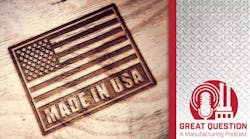In 2014, Ingersoll Rand made a global climate commitment to increase energy efficiency and reduce greenhouse gas (GHG) emissions related to our operations and products by 2020. We were one of the first industrial companies to make this kind of commitment and we are proud of our progress. Two years ahead of our 2020 target, we’ve increased energy efficiency across our operations by 10 percent, and we continue to progress toward new goals like increasing the use of renewable energy.
The path to energy efficiency isn’t always a smooth one, but we believe we can both help our industry colleagues and learn from them—for the good of the environment and, most importantly, our respective businesses.
Ingersoll Rand's Keith Sultana
Preparing for an energy efficiency initiative across your operations can seem overwhelming. However, with energy being is one of an industrial company’s biggest expenses, becoming more energy efficient is financially responsible.
There are several key tactics we executed to get where we are today. I am highlighting three which are relevant for any industrial company and will help smooth the path to energy efficiency.
Conduct an energy audit
You need to understand where your energy usage is at in order to set a baseline and identify goals. Conducting an energy audit of our major facilities provided this information and also identified system anomalies. Using this data to inform our plan, we focused on four areas to drive results:
- Updating HVAC systems
- Updating building controls and lighting
- Eliminating energy leakage from compressed air systems
- Turning systems off at night
The payoff was notable. We reduced energy use across our operations by 109,000 MM BTUs and electricity consumption by 22,000 MWh. This is the equivalent of 26 million pounds of coal, and powering 1,750 homes for one year.
Start small
We did not pursue all four elements of our plan across all of our operations at once. Prioritize projects with the best payback. Start at one location, and move outward from there.
In executing our plan at our Mocksville, NC, manufacturing facility, we produced energy savings equal to the amount of energy used by 170 houses in one year by making sure the lights are shut off after every shift. And we refitted the facility with an energy-efficient lighting system, which saves the facility 300,000 kilowatt-hours annually.
Work with suppliers
As industrial companies, we are a part of a business ecosystem which includes suppliers we work closely with every day. Your supply chain is an important part of your business model; it should be a crucial part of your energy-efficiency plan as well.
Focus on suppliers who have similar environmental priorities and who provide materials, products and services that are most effective in helping your further your footprint-reduction efforts.
At Ingersoll Rand, we created a Global Supplier Council to set policies around energy efficiency, sustainability and safety. We measure where our suppliers stand today and we help them get started. Eighty-seven percent of our suppliers are willing to collaborate with us on sustainability initiatives, and we are committed to helping them pursue sustainability goals. As a steward of the environment, we like that this mutually beneficial initiative increases our collective impact.
So what’s next?
Environmental sustainability is a corporate priority at Ingersoll Rand and core to how we run our business. Reducing energy use everywhere we can is just one aspect of our strategy to reduce GHG emissions. The other is to generate energy everywhere we can generate it.
Renewable energy has become more affordable and accessible, and we have made initial investments in on-site solar installations and a power-purchase agreement for wind power. As you set down the path to increased energy efficiency and start showing results, be thinking about the next steps you will take to achieve your goals, including exploring the potential impact of a move to renewable energy.
Keith Sultana is senior vice president, global operations & integrated supply chain with Ingersoll Rand.


